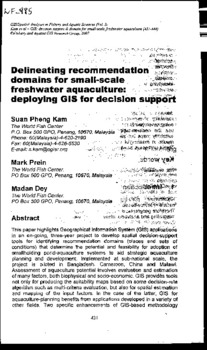Delineating recommendation domains for small-scale freshwater aquaculture: deploying GIS for decision support

Citation
Kam, S.P.; Prein, M.; Dey, M. (2007). Delineating recommendation domains for small-scale freshwater aquaculture: deploying GIS for decision support. p. 431-444. In: GIS/Spatial Analysis in Fishery and Aquatic Sciences. v. 3. Saitama, Japan : Fishery-Aquatic GIS Research Group.
This paper highlights Geographical Information System (GIS) applications in an on-going, three-year project to develop spatial decision-support tools for identifying recommendation domains (places and sets of conditions) that determine the potential and feasibility for adoption of smallholding pond-aquaculture systems to aid strategic aquaculture planning and development. Implemented at sub-national scale, the project is piloted in Bangladesh, Cameroon, China and Malawi. Assessment of aquaculture potential involves evaluation and estimation of many factors, both biophysical and socio-economic. GIS provides tools not only for producing the suitability maps based on some decision-rule algorithm such as multi-criteria evaluation, but also for spatial estimation and mapping of the input factors. In the case of the latter, GIS for aquaculture-planning benefits from applications developed in a variety of other fields. Two specific enhancements of GIS-based methodology development for factor estimation are described: for estimating pond-water availability by supplementing climatic–soil water-balance estimation with modeling the contribution of groundwater and surface flow; and for developing physical-accessibility indices based on network analysis of origin–destination travel distances and time. An econometric modeling-framework and methodologies are being developed for identifying and quantifying the factors that influence socio-economic adoption of smallholding pond-aquaculture systems. These factors will be incorporated into the GIS modeling of aquaculture potential. To investigate further the implications of the evaluated potential, fish-yield models for mono- and poly-culture of selected species are being developed for use in conjunction with GIS to determine the spatial variability of expected production. Finally, user-friendly interfaces are being developed to facilitate and encourage users who lack GIS skills to use the decision-support tool not only for generating aquaculture56 suitability maps but also for structured query and interpretation of the results in meaningful ways to support planning and decision making. These utilities will be web-enabled for wider usage.
Permalink
Date Available
Type
Publisher
Countries
Research Themes
Language